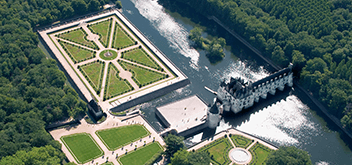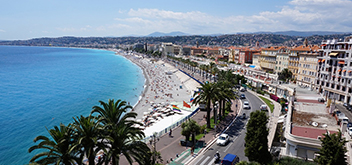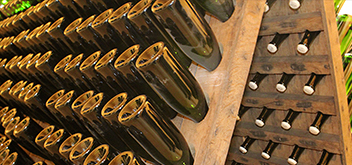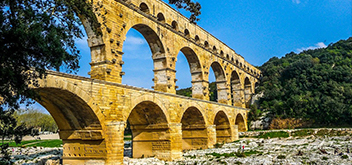No products
Amboise

From Neolithic times, the Promontory des Chatelliers rock spur has been an ideal observation post at the confluence of the Loire and one of its tributary, the Amasse.
Since the Iron Age, this site was a place of craftwork and commercial ex changes. The town became the main city of the Turones, the Celtic tribe who gave their name to the future area of Touraine. The site was fortified from this period onwards. The fortifications were progressively improved with the help of the rock.
In 503, Amboise entered into history when Clovis, King of the Francs and Alaric, King of the Visigoths met here. During the troubled period of the Norman invasions, the power of Amboise spread over the lands of the Counts of Anjou, then those of the house of Amboise-Chaumont. In 1214, Touraine was invested by Philippe-August, King of France. The family of Amboise-Chaumont became his vassal.
But in 1431 Louis d'Amboise was condemned to death for his part in the plot against La Trémouille (Arthur de Richemont), the favourite of King Charles VIII.
Eventually pardoned, Louis d'Amboise still had to renounce the Château d'Amboise, which was confiscated by the Crown.
 |  |  |
THE ILLUSTRIOUS HOSTS
The residence welcomed Louis XIII and Louis XIV several times. His grandson, Philippe, Duke of Anjou, also stayed here on the way to Spain from the II to 13 December 1700 before acceding to the throne of Spain under the name of Philippe V.
Nicolas Fouquet, the disgraced former superintendent of finance, was the involuntary guest of the Chateau d'Amboise. After giving a sumptuous feast in honour of the King of France in his château of Vaux-IeVicomte, he was arrested on 5 September 1661 at Nantes by the captain of the musketeers, the famous d'Artagnan. On his way to the Fort of Pignerol (in the Savoy Alps) where he died on 23 March 1680, he was interned at Amboise from 4 to 16 December 1661. Tradition holds that he was put in the cell situated "above the entrance door of the Chateau". His passage to Amboise became the subject of a pilgrimage for Jean de La Fontaine, his friend, who came to the Chateau in August 1663
CLOS LUCE

This residence of pink brick was built by Hugues d'Amboise on Gallo-Roman foundations in the reign of Louis XI (between 1107 and 1115). The property was then given by the king to his favourite, Etienne le Loup, a cook's assistant whom he ennobled. The estate, which was called the Manoir du Cloux at that time, was surrounded by fortifications, all that remains today being the watchtower. At the bottom of the park, Etienne Le Loup also had a dovecote, which is still intact, and which could house 500 pigeons.
Bought by Charles VIII on 2nd July 1490, the castle became a royal estate. It was to remain so for two centuries. While the Royal Court resided at the Château d'Amboise in the Loire Valley, the Manoir du Cloux was used as a secondary residence. Charles VIII had the chapel built here for the Queen, Anne de Bretagne, in mourning for her children who died young.
Later, the young Duke of Angouleme, the future Francis I, organised war games in the gardens of the Clos-Lucé. Marguerite de Navarre, the sister of Francis I, wrote the first erotic stories of "L'Heptaméron" there. It was under Francis I that Le Clos-Lucé became the house symbolising the Renaissance movement in France. Advised by his sister, Francis I had painters, architects, and poets, such as Clément Marot, who were seeking royal protection, brought here. But the greatest of those to cross the threshold of Le Clos Lucé was certainly Leonardo da Vinci.
Le Clos Lucé is one of the jewels of the Renaissance. With the exception of Le Plessis-les-Tours, it is the only chateau to have been built of both brick and tufa stone, extracted from the region's quarries. It is also one of the most furnished residences in the Val de Loire.
Apart from the hovel where he was born in Vinci, Le Clos Lucé was the only home of Leonardo da Vinci. He lived there for 3 years, from 1516 to 1519 and ended his days there. This is what gives the castle its outstanding character. In fact, Leonardo da Vinci spent his life between Florence, Milan, and Rome, offering his services as engineer, architect and artist to the rulers of the day, who acted as his protectors.
It was Francis I who brought Leonardo da Vinci to the Chateau de Cloux in 1516 and installed him there, on the advice of his sister, Marguerite de Navarre. Leonardo da Vinci travelled across the Alps, carrying with him on mule back three of his most remarkable paintings, the Mona Lisa, St. Anne, and St. John the Baptist, which he completed at Le Clos Lucé. The king granted him a pension of 700 golden Ecus a year, and Leonardo was "free to think, dream, and work". Leonardo da Vinci was treated with real affection by Francis I, who called him "my father", his sister Marguerite, and the whole Court.
Leonardo da Vinci carried out various commissions for the king as designer of Court festivals, architect, civil engineer (studies for the Canal de Romorantin, locks on the Loire), military engineer, town planner, advisor...
After writing "No being disappears into the void" and asking for holy sacrament, Leonardo da Vinci died at Le Clos Lucé on 2nd May 1519 at the age of 67. In a will drawn up by Maître Guillaume Boreau, Notary of the Royal Court, he left all his books, painting instruments and drawings to Francesco Melzi, and a fine coat to Mathurine, his serving-woman.
After its royal days, and its brief spell of genius, Le Clos Lucé experienced times of gallantry and times of bloodshed, for the beautiful Babou de la Bourdaisière, the favourite of Francis I, lived there, as did some great ladies of easy virtue and Michel du Gast, Henry III's Captain of the Guard, who was to take part in the assassination of the Cardinal de Guise.
In 1660, the Manoir du Cloux became Le Clos Lucé. It then became the property of the Amboise family, who saved it from destruction during the Revolution, cleverly invoking human rights. A listed monument, it has been the property of the Saint-Bris family since 1802.


















